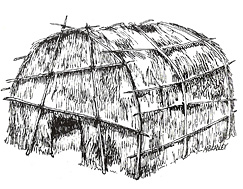first peoples
Pre-European Cultures in the Connecticut River Valley
Discovered indigenous sites and artifacts — those that survived the damp and acidic soil of southern New England — reveal a civilization well-adapted to the area's climate, topography, wildlife and vegetation. What is today called Eastern Algonquin civilization endured for perhaps two thousand years and includes the Agawam and Nonotuck groups first encountered by European settlers in the Connecticut River Valley.
The First Peoples of the valley were semi-nomadic, moving among several locations favored for fishing and hunting and the gathering and cultivation of food crops. The native people usually lived in Iroquois-style longhouses or wigwams. The circular wigwams were constructed of saplings set upright, lashed together at their tops and covered in woven mats and animal skins. Such dwellings could be built in a matter of minutes whenever shelter was needed.
Native clothing was made of well-cured, often colorfully-adorned animal skins. Lightly dressed in the summer, people wore bear skin robes in winter. Bear fat coated bodies in winter, providing insulation. Bear fat was also applied during summer as protection against insects.
Bear, deer, turkey and other animals were hunted in the open meadows of the valley and in the surrounding wooded hills. Underbrush was burned off each fall, making it easier to hunt or to spot approaching enemies. Agriculture flourished in parts of the valley, with corn, beans and squash helping to support local populations. The native people also gathered walnuts, acorns and berries.
Eastern Algonquin tools were fashioned from stone, bone, and wood. Technological developments shared by groups such as the Agawam and Nonotuck included the bow and arrow, the spear thrower and clay pottery. Some copper was available, the result of a trade network with the distant upper Midwest. Indeed, the Connecticut River Valley appears to have served as a crossroads for trade between the peoples of the Northeast.
Anthropologists, archaeologists and historians note that native culture was not static, but rather changed over time as the people adapted to environmental variations and engaged in exchange with other groups. Not until the arrival of European settlers, however, was cultural change so disruptive and traumatic.
